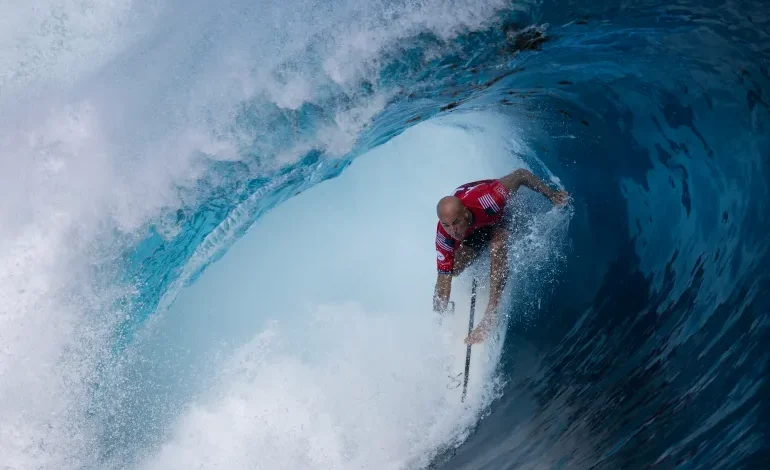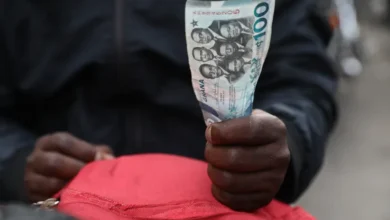Why the Olympic surfing venue is 16,000km away from Paris

Teahupo’o, which means “heap of heads” in Tahitian, is also painfully picturesque, says Tim McKenna, a veteran surf photographer who has lived on the island since 2002. McKenna has spent the past 35 years photographing the world’s best surfers on the world’s best waves but, he says, “There is nowhere else like Teahupo’o. … The water is warm and super clear. You can see the coral and the fish.”
The surrounding scenery is equally impressive: “When you catch the wave, you are surfing towards these super-green, pyramid-shaped mountains.” But what truly sets the wave apart, he adds, is that “it’s super short, super powerful and 100 percent tube. That’s why it’s so photogenic. … When the guys come out the tube, you will get the spray in your face and on your lens.” This is because there’s a channel right next to the wave that’s “so deep there’s no way anything can happen to you. Even if the waves are massive, the channel is flat.” There is, he repeats, “nowhere else like Teahupo’o in the world”.
Yet that’s not the only reason why this village of 1,455 people in southwest Tahiti has been chosen to host 48 of the world’s top surfers for the Paris Olympics starting on Saturday, 16,000km (10,000 miles) away from the capital of France.
Why is it the surfing venue for the Paris Olympics?
The short answer: French Polynesia is part of France, and it’s home to the best waves in the world. The long answer is more interesting.
Mainland France is home to some fantastic winter waves – most notably, La Graviere and Le Nord near Hossegor – but in summer, the Bay of Biscay on the west coast is largely waveless. Surfing made its debut at the Tokyo Olympics in fairly dismal conditions, and a repeat would not be good for the sport’s image. Luckily for the Olympic organisers, France’s overseas territories boast some brilliant waves.
“The best Olympic wave would probably have been Saint-Leu on the island of Reunion,” McKenna says, because it requires surfers to be able to ride barrels and perform manoeuvres. But the very real possibility of a shark attack – Reunion, east of Madagascar in the Indian Ocean, recorded 24 attacks, 11 of them fatal, from 2011 to 2019 – meant Teahupo’o was the better option.
It is also a homecoming of sorts for the sport itself.
Surfing was invented by the ancient Polynesians, who later took the pastime to Hawaii, well before the first European contact in the 16th century. During Captain James Cook’s three-month stay in Tahiti in 1769, Joseph Banks, the resident botanist on HMS Endeavour, noted in his journal: “Their chief amusement was carried on by the stern of an old canoe, with this before them they swam out as far as the outermost breach, then one or two would get into it and opposing the blunt end to the breaking wave were hurried in with incredible swiftness. Sometimes they were carried almost ashore.”
While Polynesia is the birthplace of surfing, trying to tame the death-defying tubes of Teahupo’o is a more recent endeavour. It seems the first people to surf big Teahupo’o were Hawaiian bodyboarders Mike Stewart and Ben Severson in 1986 with the waves becoming “something of an underground spot for psychotic bodyboarders”, according to Borte. (Bodyboarders, who don’t have to get to their feet to ride waves, often pioneer big wave “slabs”, which are intense and powerful waves created by very deep water crashing onto shallow rock or coral.) By the 1990s, a few gung-ho surfers had followed suit, but it was the decision to host a World Surf League (WSL) event there in 1997 that threatened to put Teahupo’o on the map.
That first event, McKenna remembers, was an unmitigated disaster. “The waves didn’t get bigger than 3-4ft [0.9 to 1.2 metres]. The wind turned onshore, and a ferry ended up getting stuck on the reef.” Fortunately, he adds, the organisers “held strong and ran the contest again the next year and the waves were amazing”.
For the 2000 competition, the waves were even bigger: “We got up the next morning, and it was like nothing I’d ever seen in my life,” event organiser Steve Robertson remembers. “It was easily 12ft [3.7 metres], but it wasn’t the size that worried us. The sheer power was unbelievable and completely uncharted territory for an event. We thought, ‘Can we really run and make these guys go out in this surf?’ We had a really good field of surfers, and it was just too perfect to call it off. We knew we could do it. So we did.” That event was won by Kelly Slater – the first of five Teahupo’o titles for a man universally acknowledged as the GOAT of surfing.
While the 2000 contest played a major role in etching Teahupo’o at the pinnacle of surfing’s totem pole, it was another moment in that same year that changed the sport of surfing forever. At 11:38am on August 17, 2000, American big wave surfer Laird Hamilton was towed into a wave using a Jet Ski. (Above a certain size, it becomes impossible to paddle fast enough to catch a wave.) Matt Warshaw, the pre-eminent historian of surfing, described the feat as “the single heaviest thing I’ve ever seen in surfing.”
McKenna, who shot the fold-out cover image for Surfer magazine, explains: “Before then people only measured big wave surfing by the size of the wave. Compared to open ocean waves, that wave was not that big, … but it was so round and so gnarly and so perfect. It opened up a whole new world of big wave surfing on slabs that previously only bodyboarders could access. It redefined what was possible.”
The wave may have been ridden only recently, but it’s been there hundreds of thousands of years – long before humans arrived on the island.
What’s French about French Polynesia?
The French were not the first European power to try to exert control over the hearts and minds of Tahitians. The Spanish and the British both tried, but from 1842 until the present day, the area has been under some form of French control. “We vote in Tahitian elections, French elections and European elections,” McKenna says with a laugh.
In the 2000s and 2010s, the independence movement – championed by Oscar Temaru, leader of the Tavini Huiraatira (Serving the Indigenous People) party – enjoyed considerable support. While Temaru won French Polynesia’s 2023 elections and his fifth term as president in a landslide, the situation is calmer (in stark contrast to nearby New Caledonia) these days, McKenna says. Temaru’s party lost two seats in the French parliamentary elections that just took place.
The decision to host the Olympic surfing event at Teahupo’o might have been more controversial if no Tahitian surfers had qualified for the games. Qualification is tough and convoluted: There are three ways to qualify, and a limit of two men and two women per country is in place. (French Polynesia is considered part of France.)
Despite having a population of just 280,000, one male Tahitian, Kauli Vaast, and one female, Vahine Fierro, who’s originally from the nearby island of Huahine, qualified for the Olympics. What made their achievement even more remarkable was that they did so not through WSL rankings but via the 2024 International Surfing Association (ISA) World Surfing Games in El Salvador. The World Surfing Games are a bit of a lottery with many of the world’s best surfers being knocked out by lesser names. What’s more, ”the conditions were completely different to what they are used to,” says McKenna, who was in El Salvador for the competition. “It was incredible how it happened, that both Kauli and Vahine qualified.”
Now that they’ve qualified, home ground advantage makes both Vaast and Fierro serious gold medal contenders, especially if the waves are big and hollow. To underline this point, Fierro won the Teahupo’o leg of the 2024 WSL Championship Tour as a wildcard, beating the world’s best surfers in massive waves on a day that’s been widely acknowledged as “one of the best days yet of women’s contest surfing”.
Judging tower controversy
For a while it seemed like the Tahitian government’s plans to build an aluminium judging tower that complied with the International Olympic Committee’s health and safety regulations might be more of a threat to holding the contest at Teahupo’o than any anti-France sentiments. A petition, championed by some big names in international surfing, argued that the tower would cause untold damage to the reef and called for the old, wooden tower to be used instead.
The waves are a 15-minute paddle from land, so judges do need a base nearby: Both the old and new towers are temporary structures that are assembled before a contest begins and removed when it finishes.
After a barge involved in the new tower’s construction struck the reef in December, the brouhaha ramped up several notches. When the ISA publicly opposed the tower’s construction, the event seemed in serious jeopardy. But thanks in part to the French Polynesian president, Moetai Brotherson – who expressed solidarity with the protesters and a willingness to move the contest to a nearby beach break – a compromise was reached.
A smaller tower with far less environmental impact has now been completed and was used in the WSL event in May. “The foundations are half the size they would have been,” McKenna says. “And they are located in an area where there’s very little coral.” While the original plans involved digging an undersea trench to house water pipes and electricity and internet cables, now the pipes and cables are simply laid on the seabed during each contest and removed when it finishes.









